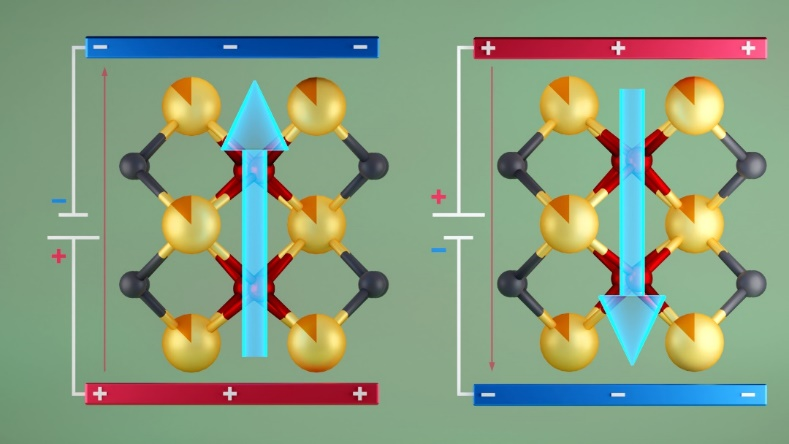Ferroelectric materials are known as substances that exhibit spontaneous electrical polarization. Polarization implies the isolation of the negative and positive charges present inside a material.
 The structure of yttrium (partially shaded orange) doped hafnia dioxide crystals exhibits ferroelectric polarization (blue arrows) that changes direction as the external electric field is reversed. Image Credit: Oak Ridge National Laboratory.
The structure of yttrium (partially shaded orange) doped hafnia dioxide crystals exhibits ferroelectric polarization (blue arrows) that changes direction as the external electric field is reversed. Image Credit: Oak Ridge National Laboratory.
This means that for ferroelectric materials, the “memory” of the material’s previous state, known as hysteresis, can store data in a manner akin to magnetic storage devices like hard discs.
Ferroelectric materials based on the element hafnium show great promise as they appear to be highly compatible with silicon computer circuits available at present compared to other potential materials.
Previously, it was possible for scientists to obtain ferroelectricity on ultrathin films. Such films could be fragile and difficult to use. Scientists have currently reported the first experimental proof of room-temperature ferroelectricity in crystals that are made of a hafnium-based compound and bulk yttrium doped hafnium dioxide.
The Impact
Hafnia-based ferroelectric materials seem to possess numerous advantages for computer memory. They provide high durability, lower operating power, speed, and the potential to hold data when power is shut down. But scientists do not completely comprehend such materials.
This study developed a creative bulk hafnia-based ferroelectric material. The outcomes offer insights into how such materials tend to behave and how to regulate them. Also, the findings eliminate the upper size limit of the materials, thereby making such materials simpler to utilize in real-world applications.
The huge sample size will help additional experiments to better comprehend the ferroelectric properties of the material. In return, this will help scientists make next-generation non-volatile memory devices.
Summary
In 1965, Intel co-founder Gordon Moore inferred that the number of transistors on a computer chip would double every two years, a prediction called the Moore’s Law. Chip manufacturers since then have been able to retain this rate of miniaturization but tend to encounter increasing difficulties as a result of the laws of physics.
Hafnia-based ferroelectric materials might help to further miniaturize non-volatile memory devices. However, scientists have not come up with a bulk form of the material.
In this study, the new bulk ferroelectric yttrium doped hafnium dioxide developed could allow such development, thereby resulting in more use of hafnia on computer chips and expanding Moore’s Law.
A research group headed by Rutgers University executed neutron powder diffraction measurements on yttrium doped hafnium dioxide with the help of the POWGEN, a general-purpose powder diffractometer instrument at the Spallation Neutron Source, a Department of Energy (DOE) user facility at Oak Ridge National Laboratory (ORNL).
POWGEN is known as a high-resolution neutron powder diffractometer allowing the magnetic, crystal, and local structures of novel polycrystalline materials to be defined. The research group synthesized single crystals of yttrium doped hafnium dioxide at several yttrium doping levels and further ground them into powder for characterization.
POWGEN data displayed that at few doping levels, the bulk phases were firm and the oxygen atoms moved to allow reversible polarization. Hence, this verifies the ferroelectricity of hafnia at room temperatures.
Other measurements, such as polarization-electric field hysteresis loop and computational simulations, aided the structural analyses, and constitute a significant step forward toward hafnia-based technologies in the future.
The study was financially supported by the Centre for Quantum Materials Synthesis funded by the Gordon and Betty Moore Foundation’s EPiQS initiative, Rutgers University, the Office of Naval Research, and the Department of Defense. The neutron characterization was performed with the Spallation Neutron Source, a DOE Office of Science user facility at ORNL.
Journal Reference:
Xianghan, X., et al. (2022) Kinetically stabilized ferroelectricity in bulk single-crystalline HfO2:Y. Nature Materials. doi.org/10.1038/s41563-020-00897-x